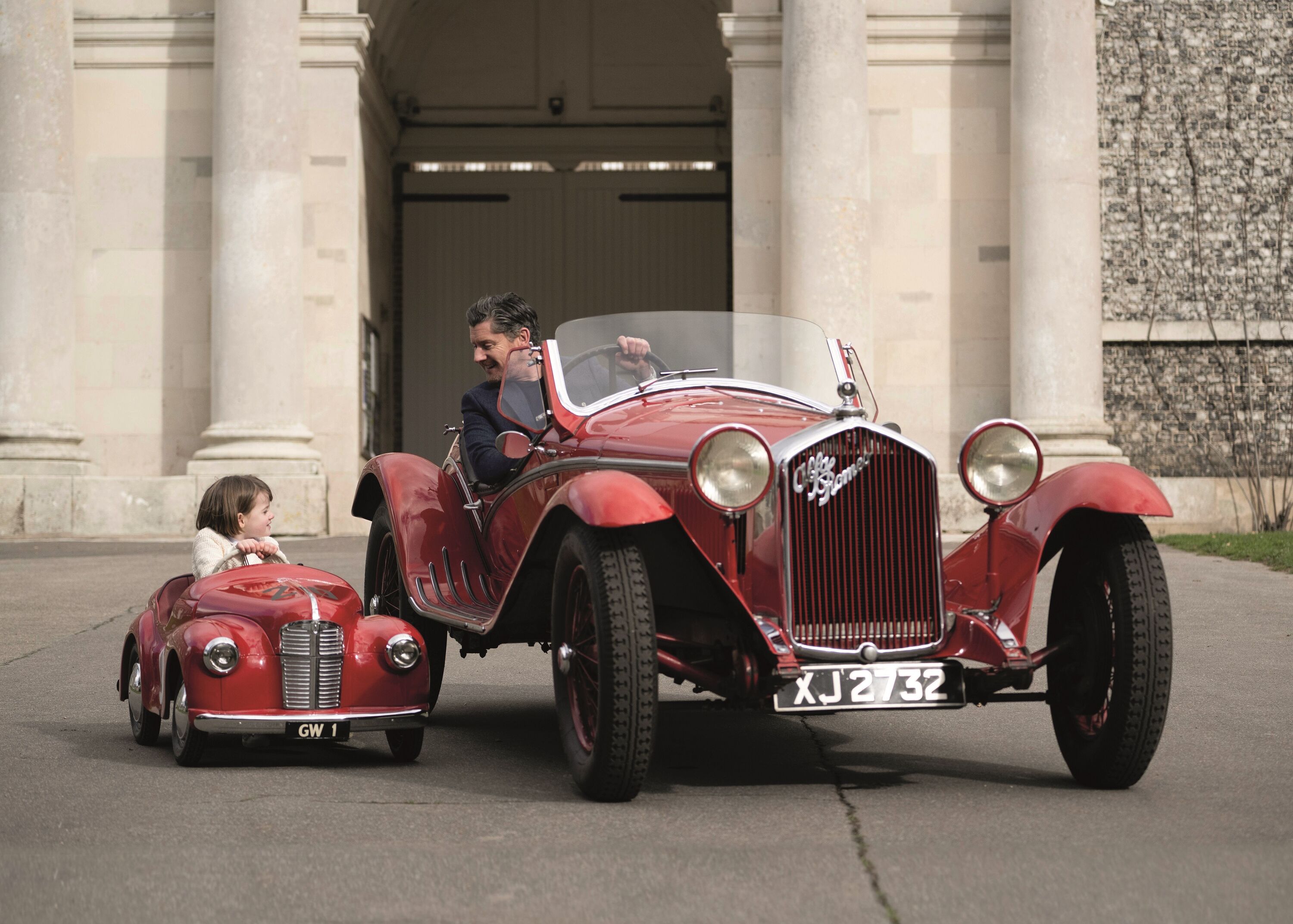
Marko was speaking about the circuit on which he and I raced in the late 1960s and early 1970s. What else could you call a 45-mile, 720-corner course that goes through the middle of three villages, skirts 1,000 feet drops and brushes against stone houses?
There have been many Targa Florio configurations, some even loonier than the circuit of my era. The original 1906 route was 92 miles long, and a later version set the all-time mark for distance as a 670-mile circumnavigation of the entire island of Sicily. Our Piccolo circuit may have been a fraction of the size of the Grande courses, but it was still unconditionally mad. It should be noted that, despite Marko’s opinion of the Targa’s irrationality, he set the fastest race lap in 1972 (33 minutes 41 seconds) at an average speed of 79.69mph and finished second overall. That pretty much sums up the inherent contradictions between how racing drivers think and how they act.

John Wyer, Porsche, Seppi and me
I returned to Sicily and the Targa in 1970 as part of one of the most famous and successful sportscar efforts in racing history, the Porsche factory team entered by JW Automotive and directed by John Wyer. Porsche built the powerful 12-cylinder 917s for high-speed circuits like Le Mans, Spa, Daytona and Monza and the nimble eight-cylinder 908/03s for the multi-cornered Nürburgring and the Targa Florio. Wyer’s cars were painted in Gulf’s iconic blue-and-orange livery and we drivers wore matching driving suits. Walking through the paddock, we looked and felt like gods.
At my request, I was paired that season with Jo ‘Seppi’ Siffert because I was sure that driving with him was the best way for me to win races. My 1968 drives in Wyer’s Ford GT40s and with the factory Porsche 908s in 1969 gave both Seppi and John confidence in my abilities. Jo and I were employed directly by Porsche while Pedro Rodriguez and Finnish rally driver Leo Kinnunen were Gulf drivers. None of us was paid that well. As factory Porsche drivers – the best job in endurance racing at that time – Seppi and I were remunerated at exactly my 1968 John Wyer rate of $750 per race plus expenses, except for Daytona, Sebring and Le Mans for which we received $1,000 each. My total 10-race income from Porsche that year was $8,250.
The Targa Florio was our fifth race of the championship season, and the first where Wyer ran Porsche’s new 908/03s. Rodriguez and Kinnunen were in one, Siffert and me in another, and Richard Attwood and Swedish rally driver Björn Waldegård in a third. To John’s surprise and dismay, another 908/03 appeared in the paddock entered by Ferdinand Piëch’s Porsche Salzburg team, to be driven by Vic Elford and Hans Herrmann.
That night’s celebratory dinner tasted of victory, washed down by copious draughts of Sicily’s inky Mount Etna wines.
Brian Redman
The agile 908/03s were perfectly suited to the serpentine Targa Florio circuit. While Elford did try a 917 in practice and lapped just a few seconds slower than his time in the 908/03, the big car proved to be a handful and was quickly returned to the Porsche Salzburg transporter. Ferrari, our major competition, sent one of its mighty 512S prototypes for factory drivers Nino Vaccarella and Ignazio Giunti. Nino was a Sicilian from Palermo, where he was a part-time teacher and accounting school headmaster. As the local pro, he trained year round on his home circuit and was one of very few drivers who knew every one of the Targa’s 720 corners. If the Porsche 917 were ill-suited to the Targa, Nino’s beefy Ferrari couldn’t have been any better. Nonetheless, after Siffert put our car on pole with a lap of 34 minutes 10 seconds and Elford set a time of 34 minutes 37 seconds, Vaccarella – using his intimate course knowledge – qualified third just 36 seconds off Jo’s pace.
The 1970 race was scheduled for 11 laps (495 miles), one lap longer than the previous year. With fuel stops, it would take just over six hours, and fuel economy was Porsche’s secret weapon. The thirsty 12-cylinder Ferrari could go just two laps before stopping while the eight-cylinder Porsche could last three or even four if we took advantage of the satellite refuelling station our team had set up in the mountains.
The lead changed numerous times during the race, shifting among Wyer’s Porsche 908/03s, the Porsche Salzburg car and the Vaccarella/Giunti Ferrari 512S. Pedro was feeling ill that day, so Kinnunen started the race and jumped into the lead on the opening lap. When Leo handed over the car to Pedro, Vaccarella was able to overtake the ailing Mexican.

I relieved Seppi on lap four and, halfway around the track, I caught Vaccarella. The only logical place to pass the Ferrari was on the long straight beside the Mediterranean but there the 5-litre 512S could use its potent horsepower to establish a 20mph supremacy in top speed. I did try to pass elsewhere but the Ferrari had Nino aboard, blocking savagely and nearly pushing me off the road in each of my attempts. Prudence and the benefit of better fuel consumption made me patient, and I remained a safe distance behind, waiting for the Ferrari to pit. When I saw Nino getting ready, I closed up fast and we made our usual quick pit-stop for fuel, tyres and driver change. The mechanics’ coordinated manoeuvres allowed Siffert to exit the pits in the lead.
At the finish, Jo and I were two minutes ahead of Rodriguez and Kinnunen (Leo setting a new lap record of 33 minutes 36 seconds) and two more in front of the Vaccarella/Giunti Ferrari.
Most races ended with appreciative cheering no matter who won, but not in Sicily, and not for a German car driven by a Brit and a Swiss. As our Porsche triumphantly crossed the finish line for the win, thousands of Italian spectators remained eerily silent, communally crushed that the victor was neither a Ferrari nor an Alfa Romeo, nor any car driven by an Italian.
It mattered not to Seppi and me. After five races together in the JW Automotive team, we finally had our first major victory, and a most satisfying one it was. For nearly 500 miles and nearly 8,000 corners neither of us had put a wheel wrong. That night’s celebratory dinner tasted of victory, washed down by copious draughts of Sicily’s inky Mount Etna wines.

The 1973 Targa Florio
In 1973 Ferrari sent two cars to the Targa Florio, Jacky Ickx and me in one and Arturo Merzario and Nino Vaccarella in the other. Strange as this may sound, considering the price this race had extracted from me two years earlier, I was happy to be there, for several reasons.
First, I was a Ferrari factory driver and wanted to remain in favour with the team so that I might continue to be employed. Drivers are a bit like movie stars: they receive the awards, are written up in the press and enjoy the fame, while the real power always lies deeper in the organisation, close to the money. Hollywood is controlled by studios, producers and directors; in racing it’s factories, owners, sponsors and team managers.
Second, I was a seasoned professional who, over five years, had accumulated a spectrum of experiences. Racing was a dangerous job and I accepted it as such, but I also truly loved my work. I reasoned that mechanical failures had caused my two accidents and I remained confident in my abilities. In all measurable ways, I was at the top of my game and my career, unthinking of potentially mortal consequences.
Even though the Targa Florio was an event of international importance, its spectators were rabid nationalists, there exclusively to cheer on Ferrari and Alfa Romeo.
Brian Redman
Third, I had the feeling that this Targa Florio was going to be an historic occasion. Prodded by Jackie Stewart, the Fédération Internationale de l’Automobile (FIA), the sanctioning body governing the International Championship for Makes, was beginning to make some inroads on racing safety. There was a message in the air that the Targa Florio had to change since it was clear to drivers and organisers alike that the risks were unjustifiable. Race fans also must have shared my premonition because they flooded the tracksides, sensing, perhaps, that this might be the last ‘real’ Targa Florio.
Even though the Targa Florio was an event of international importance, its spectators were rabid nationalists, there exclusively to cheer on Ferrari and Alfa Romeo, or at least any competitor with an Italian name. Safety barriers were non-existent so there was nothing to keep this mass of humanity from crowding the track. Historic as the 1973 race proved to be, it was no less dangerous than any other for drivers and spectators.
The 1973 Targa Florio was won by Gijs van Lennep and Herbie Müller driving a Martini-sponsored works Porsche 911 RSR. Once again, there were fatal driver and spectator accidents.

These continuing tragedies and a change in the willingness of fans to accept them prompted the FIA to mandate full guardrails around every circuit – an impossibility for 45 miles of rural Sicily. Although the Targa Florio continued to run as a madcap adventure for another four years, it did so without the factory teams and never again as an important international event. Finally, in 1977, after two drivers were killed and five spectators injured, the police stepped in and stopped the race before the end of the fourth lap.
This time the great Targa Florio was finished, forever.
Extract from Brian Redman’s book, ‘Daring Drivers, Deadly Tracks: A Racer’s Memoir of a Dangerous Decade: 1965-75’ By Brian Redman with Jim Mullen (Evro Publishing) Hardback. RRP: £50.00.
Brian Redman
Targa Florio
Flat-Out And Fearless





